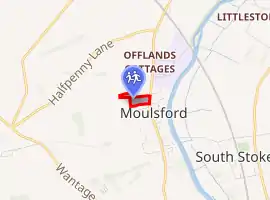Cranford House School
Cranford House School is a non-selective, co-educational independent day school for boys and girls aged 3 to 18, in Moulsford, a village in South Oxfordshire near Wallingford, England. In September 2020, a Sixth Form was added and boys were admitted into Year 7 and Year 12 with a view to the school gradually becoming fully co-educational. Established in 1931 by a Moulsford resident, Miss Winifred E Laurence, the school now numbers around 500 pupils.

| Cranford House School | |
|---|---|
| Address | |

| |
Willow Court Lane , , OX10 9HT England | |
| Coordinates | 51°33′12″N 1°09′12″W |
| Information | |
| Type | Independent day school |
| Motto | Per Salicem Ad Alta: Through the Willows to the Heights |
| Religious affiliation(s) | Church of England |
| Established | 1931 |
| Founder | Miss WE Laurence |
| Local authority | Oxfordshire |
| Chairman of Governors | Stuart Wallis |
| Headmaster | Dr J Raymond |
| Gender | Boys & Girls 3–18 |
| Age | 3 to 18 |
| Enrolment | 500 |
| Houses | Red - St. George, Yellow - St. Francis, Green - St. Christopher and Blue - St. Nicholas |
| Website | http://www.cranfordhouse.net |
School history
1931 – 1939
Cranford House was founded in 1931 as a school for one pupil, six-year-old Boris Higgs. The school's founder, Miss Winifred E Laurence taught Billy in her own home, Cranford House, a large Victorian mansion on the site of what is now Moulsford Preparatory School. Billy was joined by other children, some of them much younger, and Miss Laurence's old nursery became a schoolroom where Miss Tollit taught "the babies". The school taught traditional values within a Church of England religious framework.
The school outgrew the three rooms in Cranford House and added purpose–built rooms. The curriculum was expanded with lessons taken outdoors as much as possible and new activities added such as riding lessons, piano and percussion, carpentry for the boys, trips out and the first play, "A Market Square", produced in 1937.
The War years
During the Second World War school life continued as usual with minor adaptations. Miss Laurence opened the school during the summer holidays so that all children, including evacuees, could enjoy games, bathing and other activities. Petrol rationing meant children were rowed up the river to school or used the pony and trap.
1945 – 1980
The school was continually growing and, by 1950, when pupil numbers had reached 136, it was recognised that more space was required. The whole of Cranford House was adapted for use and a swimming pool was built. In 1953 Moulsford House was acquired and some of the school moved across the road, becoming a dual site. Cranford House was granted official recognition following an inspection by the Department of Education and Science in 1955. The same year the first link was made with Pangbourne College.
By 1961 the volume of traffic through Moulsford made crossing the road dangerous. As a result, Miss Laurence sold her home and the whole school was re-located to its current site. A sister school to Cranford House was opened near Worthing in West Sussex the same year. Called Rustington House, it had the same uniform, syllabus and ethos as Cranford. Miss Tollit took over the day-to-day running of the school and Miss Shine also spent much time there. At Cranford House a gymnasium was built in 1967 and many new activities were introduced such as canoeing, rock-climbing and national show-jumping competitions at Hickstead.
In 1969 Miss Laurence retired. She retained her interest in the school, however, and in 1975 presented it with a swimming pool on the site of the old walled garden. Miss Shine became headmistress until her retirement in 1980. Miss Shine left a school of over 300 pupils and her departure marked the establishment of a charitable trust under a Board of Governors.
1980 – The Present Day
From 1992 the headmistress, Alison Gray, adopted a more modern curriculum, adding new extra-curricular activities. A new science block opened in 1985, The Barn was rebuilt in 1988, and additional tennis and netball courts were added in 1990. In recent times the school has developed its facilities to cope with the increase in pupil numbers and changes in the curriculum. A cover was added to the swimming pool, the third science block built, along with the Orangery dining room, the Atrium/Library, an all-weather astroturf pitch and a modern, well-equipped sports hall in 2014.
In 2016 Cranford House celebrated its 85th anniversary with a choral service at Dorchester Abbey and an alumni reunion.
2018 marked the opening of a newly revamped Junior School complete with new Junior Library and brand new classrooms.
2020 saw a major re-branding of Cranford House, which included the addition of an on-site Sixth Form and refurbished Creative and Performing Arts facilities. Furthermore, the school announced the move to a fully coeducational model which started in September 2020 with boys entering the Senior School in Year 7 and the Sixth Form in Year 12. This came alongside the enhancement of the Junior School and the installation of a new STEM Centre.
Inspections
The school was inspected in 2014 by the Independent Schools Inspectorate and rated Excellent in every category.[1] It was inspected again in 2018 and met all standards.[2]
References
- Leech, Pamela (2014). "INTEGRATED INSPECTION CRANFORD HOUSE SCHOOL TRUST LIMITED". Independent Schools Inspectorate. Retrieved 5 January 2021.
- Telfer, Alistair (2018). "Regulatory Compliance Inspection Report Cranford House School". Independent Schools Inspectorate. Retrieved 5 January 2021.
External links
- School Website
- Profile on the ISC website
- ISI Inspection Reports